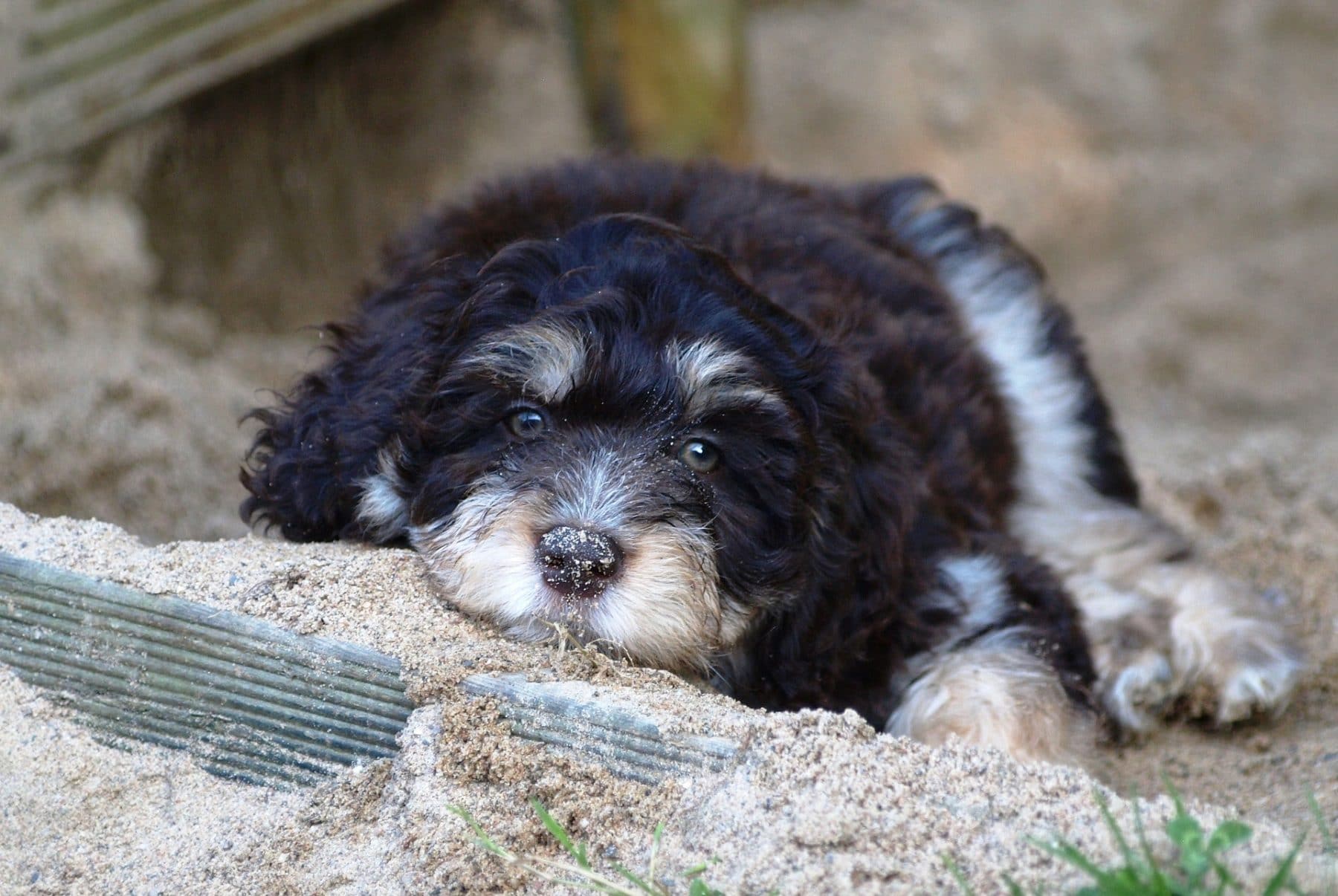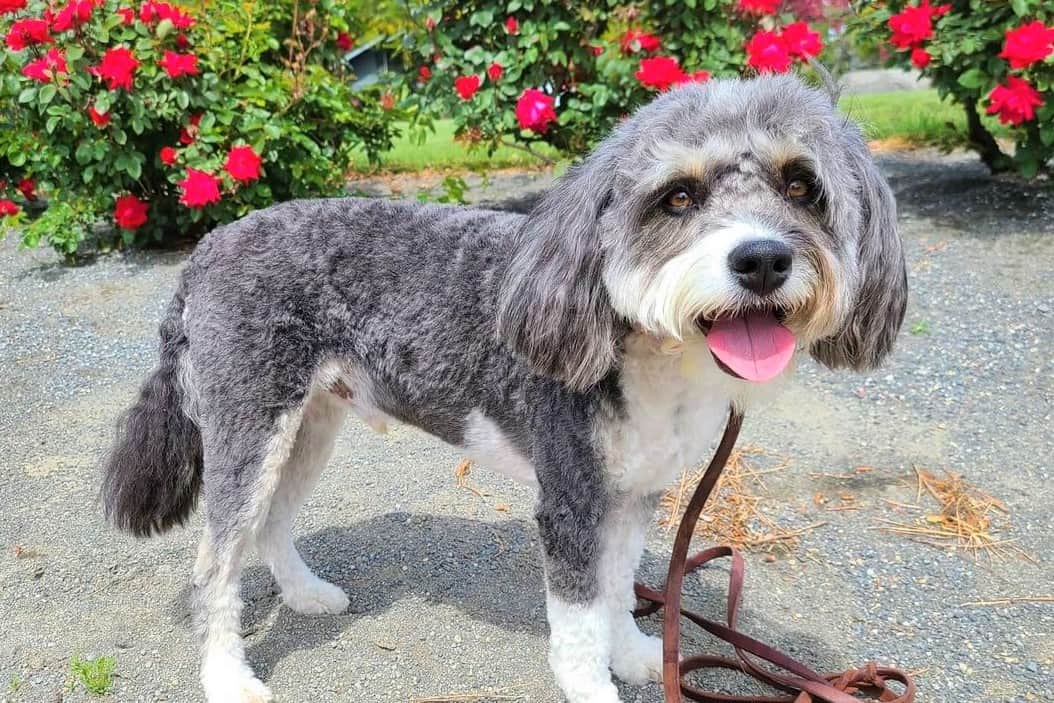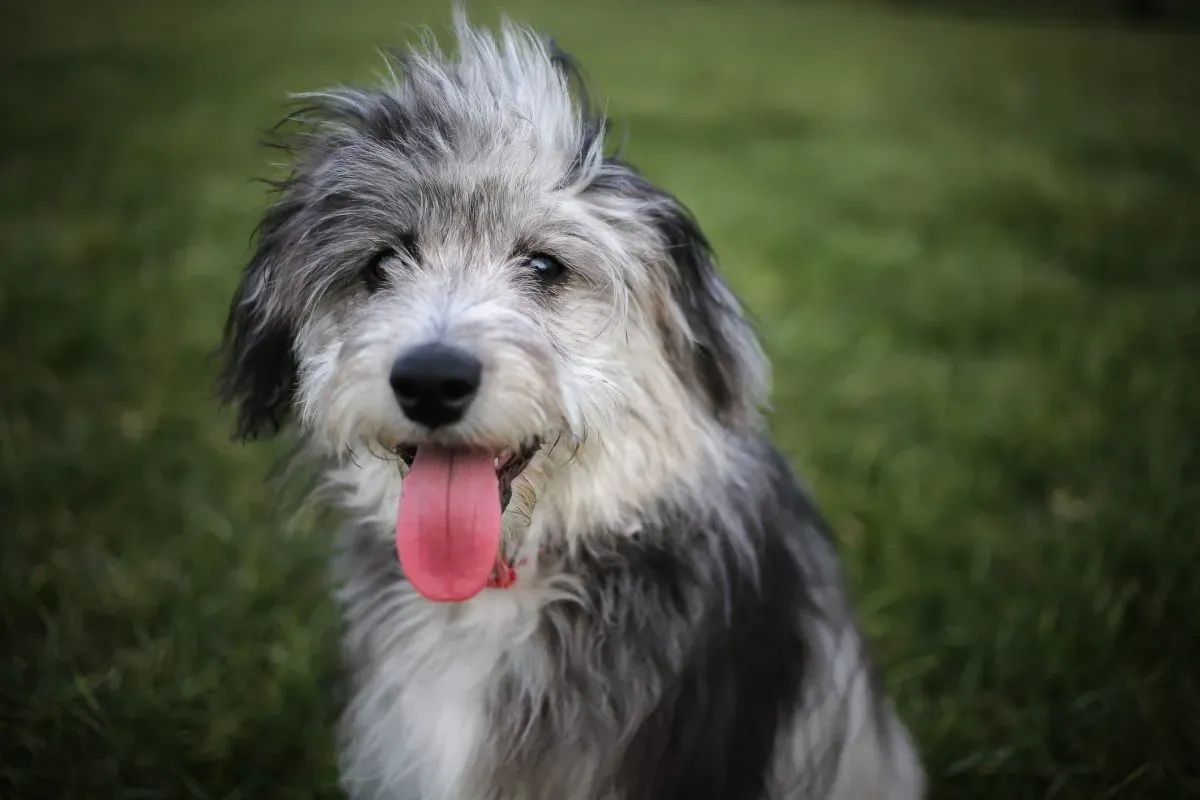Aussiedoodles, a popular hybrid dog breed that combines the intelligence of the Australian Shepherd with the hypoallergenic coat of the Poodle, often generate curiosity regarding their coat type. While traditional dog breeds can have either hair or fur, the terminology can lead to confusion. Hair and fur are chemically identical, consisting primarily of keratin, but they differ in their growth cycles and textural qualities, which can affect allergenic properties and grooming requirements.

For Aussiedoodles, their coat is generally referred to as 'hair' due to its resemblance to the Poodle's characteristic coat. The hair of an Aussiedoodle tends to be long, wavy or curly, and less dense than fur. This type of coat grows continuously and does not shed seasonally as much as fur, which is why Aussiedoodles are often recommended for individuals with mild pet allergies. The specific qualities of an Aussiedoodle's coat can vary, influenced by genetic factors inherited from their parent breeds.
Regular grooming is important to maintain the health and appearance of an Aussiedoodle's coat. Without frequent brushing, their hair can easily become matted, which is uncomfortable for the dog and can lead to skin issues. Professional grooming may also be necessary to trim the hair and keep it at a manageable length, ensuring the Aussiedoodle remains clean and tidy. As this hybrid breed is recognized for its friendly demeanor and luscious locks, potential owners should be prepared for the grooming commitment associated with their unique hair.

Aussiedoodles Overview
Aussiedoodles are a crossbreed combining intelligence and the playful nature of Australian Shepherds with the hypoallergenic coats of Poodles. They are designed to inherit the best traits from both parent breeds, making them excellent companions.
Origins and Breed History
Aussiedoodles are a relatively new crossbreed, often regarded as ""designer dogs."" This hybrid was first intentionally bred in the United States. The Poodle, praised for its high intelligence and low-shedding coat, is combined with the Australian Shepherd, known for its herding skills and energetic demeanor. This blend aims to produce a smart, trainable, and family-friendly dog.
Physical Characteristics
Aussiedoodles vary in size and weight, typically categorized as miniature, small standard, or large standard. Their coat can be wavy, curly, or have a straight texture, coming in a wide array of colors such as black, red, tan, white, chocolate, blue merle, and red merle. Notably, they have a single-layer coat with no undercoat. Their distinct appearance often includes expressive eyes, bushy eyebrows, and floppy ears.
Breed Temperament
They showcase a playful and affectionate temperament, thriving on human interaction. Their intelligence makes them quick learners, and they are generally best known for being energetic and athletic. Aussiedoodles can form a strong bond with families and particularly enjoy being involved in activities that stimulate them both physically and mentally.
Health Profile
Aussiedoodles are susceptible to certain health issues, including hip dysplasia and epilepsy, commonly seen in many purebred and crossbreed dog breeds. Regular veterinary checkups can help maintain their overall health and identify concerns early on.
Exercise and Activity Needs
This crossbreed has a high activity level, requiring regular exercise to manage their energy. Activities like dog sports, fetch, and long walks are often enjoyed by Aussiedoodles. Dog sports can provide both physical and mental stimulation, keeping them well-balanced and content.
Training and Socialization
Early puppy training and socialization are critical for Aussiedoodles. Utilizing positive reinforcement techniques works well with their eager-to-please nature. Since they may inherit the herding instincts of the Australian Shepherd, structured guidance can help harness these tendencies appropriately. Aussiedoodles often make excellent therapy dogs due to their blend of intelligence and sociable nature.
Hair or Fur?
Aussiedoodles, a crossbreed between Australian Shepherds and Poodles, possess unique coats that are a blend of their parents' hair and fur characteristics. This section explores their coat types, hypoallergenic traits, implications for allergies, and essential grooming practices.
Understanding Coat Types
Aussiedoodles can inherit a variety of coat types, ranging from the Poodle's curly hair to the Australian Shepherd's wavy or straight fur. The type of coat is determined by the gene combination the Aussiedoodle receives from its parents. Their coats can be categorized mainly as hair coats, which are single-layered, or fur coats, which typically include both a topcoat and an undercoat.
Hypoallergenic Qualities
The term ""hypoallergenic"" is commonly used to suggest that Aussiedoodles may be less likely to cause allergic reactions. While no dog is completely hypoallergenic, Aussiedoodles are often considered more suitable for people with allergies due to their Poodle lineage, which tends to have hair that sheds less and retains fewer allergens.
Shedding and Allergies
| Coat Type | Shedding | Allergy Potential |
|---|---|---|
| Hair Coats | Low to None | Lower |
| Fur Coats | Moderate | Higher |
Aussiedoodles with more Poodle-like coats often have less shedding, reducing the spread of dander and allergens in the home. Conversely, those with more Australian Shepherd-like coats may shed moderately, potentially increasing the risk of triggering allergies.
Maintenance and Grooming
Regular grooming is crucial for maintaining the health and appearance of an Aussiedoodle's coat. This includes frequent brushing to prevent matting, bathing to keep the coat clean, and nail trimming to ensure their comfort and health. The grooming requirements vary depending on the coat type:
- Hair Coats: More frequent brushing to avoid tangles; may require professional grooming.
- Fur Coats: Regular brushing to manage shedding and remove debris from the undercoat.
Grooming Aussiedoodles
Grooming an Aussiedoodle requires regular care due to their unique coat that can vary from wavy to quite curly, making them prone to matting. A disciplined grooming regimen is crucial for their well-being and appearance.
Typical Grooming Needs
Aussiedoodles typically have a mix of hair similar to the Poodle's curly coat and the Australian Shepherd's straighter fur. They are low to non-shedding but require regular grooming to prevent mats and tangles. Brushing should be done several times a week with a slicker brush to effectively remove loose hair and maintain the coat's health.
- Frequency: At least 3 times a week
- Tools: Slicker brush, comb
- Objective: Prevent matting, distribute natural oils
Bathing and Cleanliness
Bathing should not be too frequent to avoid drying out the Aussiedoodle's skin. A safe, dog-appropriate shampoo is recommended, and care should be taken to remove all dirt without over-bathing, which can lead to irritation.
- Frequency: Every 4-6 weeks
- Shampoo: Use a mild, dog-appropriate product
Haircut Styles
To manage their curly and potentially long hair, popular Aussiedoodle haircut styles include the puppy cut, teddy bear cut, and poodle cut. Each style varies in length but all aim to keep the dog comfortable and the coat manageable.

- Puppy Cut: Even, short length all over the body
- Teddy Bear Cut: Slightly longer than the puppy cut, with a rounded face finish
- Poodle Cut: Maintains the characteristic poodle style, with variations possible
Professional Grooming
Seeking a professional groomer is beneficial for owners who are not comfortable or experienced with cutting hair. They can expertly handle the intricacies of Aussiedoodle grooming, which is important to reduce the chances of the dog's coat becoming matted.
- Benefits: Professional expertise, proper tools
- Recommendation: Every 4-8 weeks, depending on the coat
Ear and Eye Care
The ears and eyes of an Aussiedoodle require regular checks to prevent infections. Ears should be kept clean and dry, while the hair around the eyes needs trimming for clear vision and to avoid irritation.
- Ear Cleaning: Soft cleaner, avoid water ingress
- Eye Cleaning: Gentle wiping, regular hair trimming
Nail Care
Nail trimming is an essential part of grooming. Nails that are too long can cause discomfort or affect the Aussiedoodle's gait. Trimming should be done carefully to avoid cutting the quick.
- Frequency: Every 1-2 months
- Tools: Nail clippers or grinder
- Note: Consult a professional if unsure how to trim nails safely
Aussiedoodle Lifespan and Care
Caring for an Aussiedoodle involves a combination of proper nutrition, regular health checks, and understanding their potential lifespan. These measures ensure the wellbeing of these family-friendly dogs over their lifetime.
Nutrition and Diet
An Aussiedoodle requires a balanced diet that is rich in nutrients to maintain its health and energy levels. High-quality dog food, either commercially manufactured or home-prepared with your vet's supervision, should consist of:
- Fresh meats for protein
- Vegetables
- Whole grains
Providing a diet tailored to the dog's age, size, and activity level is crucial.
Health Monitoring
Routine health checks are essential for preventing and identifying health problems early on. Owners should schedule regular veterinary visits that include:
- Vaccinations to prevent common diseases.
- Regular dental checkups to maintain oral health.
- Weight checks to prevent obesity, which can lead to other health issues.
Monitoring for signs of inherited health issues common in Aussiedoodles, such as hip dysplasia or specific eye conditions, is also important.
Aging and Longevity
Aussiedoodles have a lifespan that generally ranges between 12 and 15 years. To support a long and healthy life, owners should:
- Adjust care routines to accommodate an aging dog's changing needs.
- Provide moderate daily exercise to maintain muscle tone and joint health.
- Monitor for age-related health problems and consult the vet when changes are noticed.
Common Training Approaches
Training approaches for Aussiedoodles typically leverage their high intelligence and energy to achieve successful outcomes. Consistency and positive reinforcement form the bedrock of their training.
Basic Obedience Training
When training an Aussiedoodle, starting with basic obedience training is essential. These dogs are eager to learn and respond well to commands such as sit, stay, come, and heel. They thrive on positive reinforcement techniques, where rewards for correct behavior include treats, praise, or playtime. This not only aids in building a bond with the family but also keeps the Aussiedoodle's activity level in check. Ensuring regular practice sessions helps maintain their focus and prevents the development of undesirable behaviors.
Advanced Training and Sports
Aussiedoodles, known for their agility and sporting capability, are excellent candidates for advanced training and sports. Dog sports like agility, flyball, and frisbee take advantage of their natural energy and problem-solving skills. Structured training in these activities can channel their energy positively.

- Therapy Dog Training: Aussiedoodles may also excel as therapy dogs due to their gentle nature and intelligence. Successfully trained therapy Aussiedoodles can provide comfort and support to those in need.
- Ongoing Training Needs: Continuous training is beneficial for Aussiedoodles. It keeps their minds engaged and bodies active, reinforcing their skills and strengthening their ability to cope with different situations.
Activities Suitable for Aussiedoodles
Aussiedoodles, a blend of Australian Shepherd and Poodle, are known for their intelligence and high energy levels, making it essential to involve them in activities that stimulate both their minds and bodies.
Games and Mental Stimulation
Aussiedoodles thrive on mental challenges due to their sharp intelligence. Puzzle games and trick training can significantly benefit their cognitive development. They excel in activities like:
- Hide and Seek: Helps to strengthen their problem-solving skills and the bond with family members.
- Interactive Toys: Use toys that dispense treats as rewards to keep their brain engaged.
By regularly engaging Aussiedoodles with mentally stimulating games, owners can ensure their dogs are well-rounded and content.
Physical Exercise Options
Due to their athletic nature, Aussiedoodles require ample physical exercise to maintain their health and happiness. Their activity level calls for a variety of exercise options, including:
- Daily Walks: Aim for at least 30 minutes to an hour of brisk walking.
- Fetch and Frisbee: Excellent for satisfying their instinctual herding and retrieving drives.
These dogs also excel in dog sports, where they can showcase their agility and training, such as:
| Dog Sport | Description |
|---|---|
| Agility Competitions | Navigate obstacle courses with precision |
| Flyball | Relay race with balls and hurdles |
| Herding Trials | Channel natural herding instincts |
Regular, vigorous exercise is vital for keeping Aussiedoodles' energy levels managed, ensuring they remain active and avoid developing destructive behaviors.
Choosing an Aussiedoodle
Before selecting an Aussiedoodle, potential owners should carefully consider the breeder's reputation, decide between a puppy or an adult, weigh adoption options, and understand the financial commitments involved.
Selecting a Breeder
Choosing a reputable breeder is crucial when looking for an Aussiedoodle. Prospective owners should seek breeders who provide clear health screening results for both parent breeds, the Australian Shepherd and the Poodle. It is important to ensure that the breeder focuses on the health and socialization of the puppies, as these factors greatly impact the Aussiedoodle's integration into a family.
Puppy or Adult?
Deciding between a puppy or an adult Aussiedoodle requires consideration of time and commitment to training. Puppies necessitate comprehensive puppy training and socialization to thrive in a family environment. Conversely, adults may be a better fit for those looking for a less intensive training commitment, but it's important to understand the adult's history and temperament.
Adoption Considerations
Adoption offers an alternative to buying from a breeder and can be a suitable option for families open to providing a home for an Aussiedoodle in need. When considering adoption, one should inquire about the dog's background, health, and behavior to ensure they can meet the dog's needs.
Costs and Budgeting
Owning an Aussiedoodle involves various expenses that go beyond the initial cost. A structured budget should account for:
- Initial Costs: Purchasing price, vaccinations, and spaying/neutering.
- Ongoing Costs: Food, grooming, routine veterinary care, and emergency health expenses.
- Training and Socialization: Classes or resources to promote a well-adjusted pet.
Budgeting for these expenses ensures that a family can provide a stable and caring environment for their Aussiedoodle.
Frequently Asked Questions
Aussiedoodles, a cross between an Australian Shepherd and a Poodle, have hair that resembles the Poodle's non-shedding coat. This section addresses common questions related to their coat, shedding, grooming, and other characteristics.

- What kind of coat is typical for an Aussiedoodle?
- The typical coat of an Aussiedoodle is soft, wavy to curly, and often resembles the Poodle's hypoallergenic hair rather than fur. This type of coat is less likely to shed and may be preferable for allergy sufferers.
- How much do Aussiedoodles typically shed?
- Aussiedoodles are generally low-shedding dogs. The amount they shed may vary depending on their individual coat type, which can range from wavy to very curly, like that of the Poodle parent.
- What are the grooming needs for Aussiedoodles?
- Aussiedoodles require regular grooming to maintain their coat's health and appearance. They should be brushed several times a week to prevent matting and may need professional grooming every 6-8 weeks.
- Is it common for Aussiedoodles to enjoy water?
- Many Aussiedoodles inherit a love for water from their Poodle lineage. However, individual preferences can vary, and not all may enjoy swimming or water activities.
- What are the distinctive features of an Aussiedoodle's bark and temperament?
- An Aussiedoodle's bark can vary but is typically moderate in tone. They are known for being highly intelligent, friendly, and energetic, often mirroring the temperaments of both the Australian Shepherd and the Poodle.
- Are there any special considerations for trimming an Aussiedoodle's coat during warmer seasons?
- During warmer seasons, it's important to keep an Aussiedoodle's coat trimmed to prevent overheating, but they should never be completely shaved. The coat provides protection from the sun and helps regulate their body temperature.




